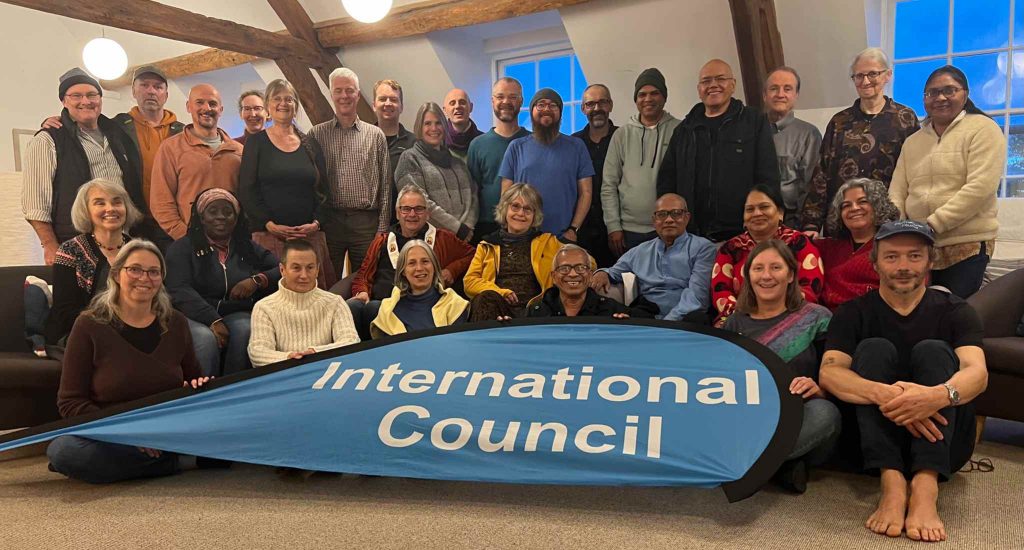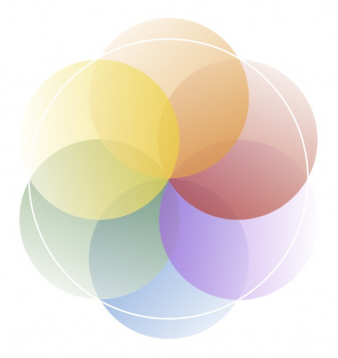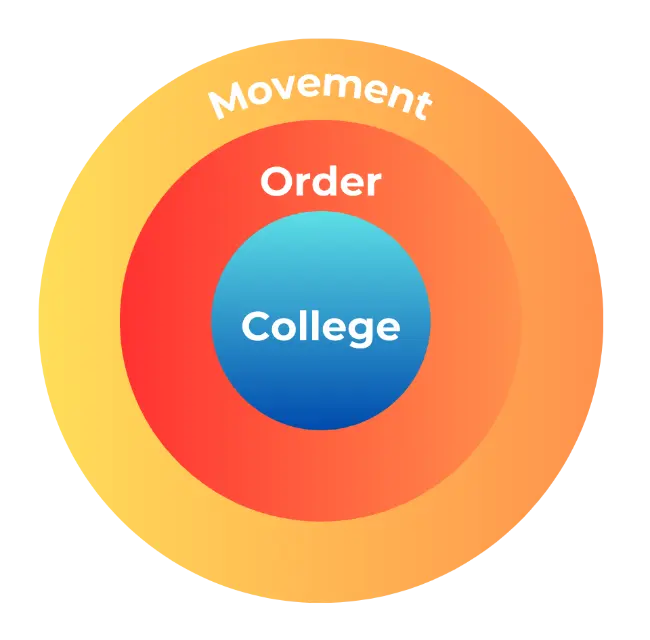The basic idea
How do you ensure the vitality of an international Buddhist Movement?
Triatna has developed a collaborative global structure that seeks to achieve a high level of consensus on important issues as it navigates the challenges and opportunities of the modern world.

In more detail...
The purpose of the IC
The International Council brings together the perspectives of those holding key responsibilities across the Triratna Community to develop strategy, provide guidance, and enable collaborative decision-making worldwide

Aims and ethos
Aims of the IC
Effective consultation, decision-making and coordination
To facilitate strategy, effective decision-making, collaboration and coordination based on a high degree of consultation within and across the three key Strands and six geographical areas of Triratna.
Commonality, unity and harmony
To promote commonality, unity and harmony within the Triratna Community so that everyone can have confidence that they are participating in the same Movement.
Spiritual standards
To offer guidance and support so that all aspects of the Triratna Community, especially new developments, are rooted in our core spiritual values, which derive from Urgyen Sangharakshita’s presentation of the Dharma.
Ethical standards
To offer guidance and support so that all aspects of the Triratna Community exemplify high ethical standards in alignment with the precepts.
Guidance and support
To give those in a position of responsibility access to guidance and support from peers and more experienced Order Members.
All within an ethos of:
Altruistic/Bodhicitta intention
Triratna as a force for good across time and space – taking the Dharma into the world.
Spirit of kalyana mitrata
Exemplification of kalyana mitrata in our work and communication with fellow Order Members. Enjoying each other’s company – working together with trust, confidence, openness, freedom, creativity, and boldness.
Common purpose
Encouraging common understanding and purpose whilst being sensitive to national and cultural differences.
Effective work practices and processes
Effective and sustainable processes to do our work – welcoming and learning from constructive feedback.
Maintaining the Triratna lineage (tradition)
Helping Triratna to thrive following Bhante’s death – continuing his vision and presentation of the Dharma, drawing on his and Dr Ambedkar’s teachings.
Various lovely members of the IC read our aims and ethos.
There are subtitles – click the captions button (which can auto-translate into many different languages)
Strategic priorities
Over time our priorities change as new circumstances emerge but here are some key priorities identified in our meeting in late 2022 (in more detail here)
Read about our strategic priorities
1. Strengthen the lineage of responsibility: – support the spiritual and leadership development of those who occupy – and will occupy – positions of responsibility within Triratna. Clarify how decisions are made and by whom.
2. Develop effective communications: – develop and coordinate Triratna’s internal and external communications to encourage greater confidence, learning, depth, and harmony within our community; share the best of what Triratna offers to existing and new audiences; and respond in a timely and constructive manner to external media interest.
3. Young people – continually attract and support young people for a Dharma life within Triratna.
4. Wealth creation and management – generate, liberate, and invest financial resources to fund Triratna’s essential institutions
5. Develop situations of transformative intensity: – create and support new opportunities for Triratna Buddhists to live, work and be together in ways that significantly deepen their experience of kalyana mitrata, and their understanding and practice of the Dharma
6. Develop Triratna as a truly international Buddhist community: – create the means for information and inspiration within Triratna to flow easily across languages and national boundaries
7. Encourage diversity of different kinds: – encourage a Triratna culture that is aware and respectful of individual and group differences so that it becomes more accessible and welcoming to an increasingly diverse range of people who want to learn and practice the Dharma as interpreted by Sangharakshita
8. Dharmic engagement with social/ecological issues: – encourage the development of a specifically Dharmic vision of, and approaches to, social/ecological issues
9. Deepen understanding and trust between the three strands: – encourage and support harmony within and between the College, Order and Movement strands; and deepen confidence in their shared path of practice
The history of the International Council
In 2009, it was recognised that we needed a structure for ‘joining up’ those taking responsibility in various Triratna contexts across the world. After substantial consultation, what emerged was recognition of the ‘three strands’ of College, Order and Movement in 6 distinct geographical areas.
More about the history
Sangharakshita gave his blessing on the suggested protocol as part of a healthy succession plan for our community, helping us to pass on his own duties, responsibilities and inspiration.
At the 1st International Council meeting in 2011, at Padmaloka (UK), the themes explored included:
- a shared system of training
- ways of engaging the Order
- funding the Order & Movement
In 2013, at Nagaloka (India), the themes were:
- intensity of practice (led to dialogue with the Order on system of practice)
- ethical and spiritual standards (promoted discussion on addressing serious ethical issues)
- leadership in transition (supporting growth and development of the Movement)
2016, at Adhisthana, themes were:
- system of spiritual life (led to work on commonality and evaluating new developments)
- maintaining unity (led to consultation on What is a Triratna Centre?)
- ethical and spiritual standards (led to recommending ethical & conflict resolution guidelines)
2018, at Bhaja (India) outcomes included:
- overview of Sikkha project
- conflict resolution proposal
- a review of structures: What is a Triratna Centre
- support for movement coordinators
- 20/20 vision: ‘think tanks’ to input into a strategic vision for our community
Due to the pandemic, the IC met online exploring:
- authority in the spiritual community
- commonality
- principles for social engagement
You might also like to watch Dhammarati’s beautifully made video from 2019 presenting a brief history up to that point
The membership and constitution
(working arrangements)
Currently, membership of the IC has 2 delegates per strand per Area. So that’s 2 x 3 (strands) x 6 (Areas) = 36! Plus some members of the Steering Group not already included (that’s the Chair of the College, the 2 International Order Convenors, the International Movement Coordinator and another with a Movement perspective). Each delegate is selected in consultation with the strand in that Area. You can see who is currently serving on the IC further down this page (‘Who is in my Area Council’)
Who are the ‘staff’ of the IC?
Much work is done by volunteers in their ‘spare’ time but there are some supported workers (mostly funded by Future Dharma Fund, some co-funded with the ECA, Order Office and Windhorse Trust):
- Jñānagarbha, full-time convenor
- Aparajita, part-time assistant
- Jnanadhara, full-time International Movement Coordinator
- Vajrasura, part-time administrator for the Sikkha Project
How to participate in the International Council
Membership of the IC consists of those actively taking responsibility in one of the 3 strands in a given Area. Typically, the Order strand will have regional Order Convenors as delegates and the Movement strand will largely comprise of Chairs of Centres. So if you wish to put yourself forward to be a delegate you will need the support of your strand in your Area.
Otherwise, have a look below to see who is on your Area Council, and you can get in touch with them to raise concerns or share ideas etc.
Who is in my Area Council?
India
Abhayadana (College)
Amrutdeep (College)
Ratnasila (Order)
Maitridarshini (Order)
Suchiratna (Movement)
Pradnyaveer (Movement)
Dipavati (Mitra Convenors)
Ratnadarshi (Mitra Convenors)
Latin America
Jnanadakini (College)
Nagapriya (College)
Medhavin (Order)
Saddharuci (Order)
Abhayasara (Movement)
Bodhikamala (Movement)
Oceania (Australia/New Zealand)
Ratnavyuha (College)
Vajrajyoti (College)
Akashasri (Order)
Dharmaraja (Order)
Ratnajyoti (Movement)
Suvarnadhi (Movement)
Mainland Europe
Amogharatna (College)
Kulanandi (College)
Simharava (Order)
Parina (Movement)
Silamani (Movement)
North America & Canada
Amala (College)
Viradhamma (College)
Samayasri (Order)
Sravaniya (Order)
Prasadachitta (Movement)
Ananta (Movement)
UK & Ireland
Suchimani (College)
Vajrasura (College)
Jayadevi (Order)
Amoghavajra (Order)
Bodhivamsa (Movement)
Vimaladasa (Mitra Convenors)
Viryanaya (Mitra Convenors)
Who is in the Steering Group?
Some members of the Steering Group, which meets monthly online, are ex-officio ie they participate on the basis of an existing responsibility, such as being Chair of the College, or an international Order Convenor.
Chair: Mahamati (College)
Parami (College, Latin America)
Vajrapriya (International Order Convenor)
Jnanadhara (International Movement Coordinator)
Bodhikamala as a guest (Movement)
Vajrashura as a guest (College deputy)
Jñānagarbha (International Council Convenor)
Contact Us
We gratefully acknowledge funding from Future Dharma Fund
Please give generously at futuredharma.org



